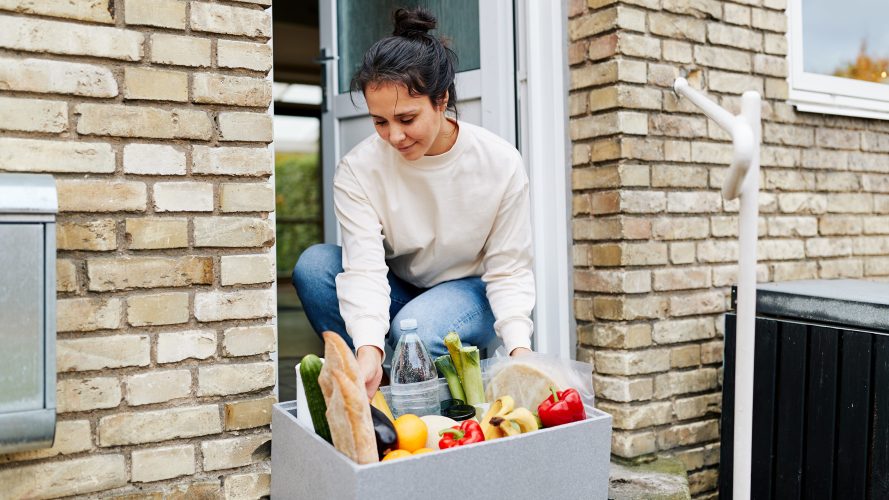Beyond Milk: Satisfy Shopper Cravings for Kombucha and Convenience



Shoppers have increasingly sophisticated tastes and diverse requests for their grocery stores. Get them the foods they crave in the ways that work best for their lifestyle.
Ordering groceries online is a trend that’s gaining traction; 68% of consumers said they will likely buy essential goods online after the health threats of the virus subside. What might have started as a way to avoid exposure to COVID-19 has become a welcome opportunity to free a few hours. But if your grocery store isn’t offering digital options, you could lose customers to the competition. In my 15 years at Salesforce and three focused on the grocery industry, I’ve seen (and I’m sharing below) a few tricks that modern grocery retailers could use to stay relevant and keep customers coming into their (virtual) doors.
Stay on top of shopper preferences
See year-over-year trends in digital shopping, view growth by category, and track consumer behavior by device.



Shoppers order groceries from a growing number of sources. Big-box stores, online marketplaces, and even restaurants sell ingredients directly to consumers. And many already have a well-established digital channel that’s meeting shoppers’ desire for convenience in selection and delivery.
If you’re thinking of launching your own digital grocery store, or if you have an ecommerce storefront that could use a boost, consider selling more than just the essentials. Follow this proven advice to provide easy ordering and delivery options in order to maintain — and grow — your shopper base.
First, create your digital grocery storefront
Set up a digital storefront, either on your own or with a partner. Make sure it’s optimized for mobile, since mobile orders of food and beverages are growing even faster than those placed from a computer, according to the Salesforce Shopping Index. In the first quarter of 2021, mobile orders were up 145%, compared to a 94% increase in computer orders.
Add options like a personalized portal that can take each shopper to their favorite items or past orders. A product recommendation engine can show them ideas that would enhance their selections or round out their meals.
Offer prepared meals and heat-and-eat options
As people emerge from home, they’ll have less time to bake sourdough bread and create artful salads. Dining in restaurants and bringing home takeout can affect grocery habits, but stores can still compete on convenience and price. Expand your prepared foods, or get into the meal-kit business.
Look into adding a ghost kitchen into your space, meaning a commercial kitchen for delivery or take-out only. Many started during the pandemic and will probably continue to operate. These standalone facilities prepare high-quality, sometimes restaurant-branded meals and snacks which stores can stock on their shelves or add to their delivery options.
Another option is to partner directly with local restaurants and distribute their meals that are ready-to-eat, ready to heat-and-eat, or just need a few finishing touches, like adding dry ingredients or dressing to a salad. With these options, you can drive more traffic to your store, as shoppers can pick up a few easy meals along with their milk, bread, and produce, all from a single location.
Manage the last mile (and give your customers options)
Whether shoppers come to the store for groceries, or do it online, they appreciate delivery options. In-store shoppers may need help getting groceries home, while online shoppers might want to pick up their purchases in-store or curbside.
Set up a digital delivery system to match shoppers with time slots and provide all the information they’ll need to get their order. Personalize their experience with special rates for an annual or bi-annual subscription, or a recurring time slot. You could also partner with local delivery apps or transportation companies so they can handle the details.
Cater to food trends and tastes
Plant-based meals, fermented foods, vegan alternatives, oat milk, hot cocoa balls — consumers’ tastes are always evolving. Stay on top of dietary trends and offer in-demand products. Be aware that many trends are location- or demographic-based. Not everyone is going to want Oreo sushi right away, but you should be prepared for those who do.
How can you know what your shoppers will want? Collect accurate data about shopper interest and sales and analyze it with the help of artificial intelligence (AI). What you learn can lead to new insights and business ideas. A spike in demand for meat alternatives, for example, could inspire you to create a vegan hot dog meal kit or encourage your restaurant partners to create a new prepared meal.
Enable automatic shopping with subscription services
Make shopper experiences easier by offering a subscription service. They can create a standing order of staple items they need for a week (or a month). Grocery subscriptions encourage them to do repeat business with you, rather than try out a competitor or pick up items at other stores.
Consumer preferences are always evolving, so your digital toolbox must expand to accommodate demand. Consider all the ways you can make grocery shopping as convenient as possible for customers and solidify each store’s essential role in its community.
Discover how to give grocery shoppers what they want
Improve your online grocery store with personalized experiences and customer convenience.



























